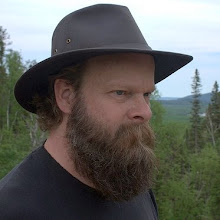
We have a favourite canoe trip: from our cottage to Bloody Lake. To reach it you have to paddle 45 minutes, then portage across an old beaver dam. Beavers built it decades ago—the dam was there when I was a child—and have maintained it ever since, flooding the area behind and killing trees around the large pond and stream there.
The trunks still stand with branches outstretched, bleached by sun and weather. Great blue herons have colonized them.
Around the verge of the water, wide mats of vegetative matter have spread, creating a bog habitat. Lacking soil, bog plants must resort to unusual mechanisms to obtain nutrition. I have found four species of carnivorous plant. Round-leaved sundew or Drosera rotundifolia captures insects on sticky red threads that cover its leaves. Horned bladderwort (Utricularia cornuta) and purple bladderwort (U. purpurea) capture small underwater creatures with tiny snares. Most imposing, pitcher-plant or Sarracenia purpurea, possesses pitcher-shaped leaves containing water to trap, drown and digest insects. Its maroon clumps are easy to spot on the green sphagnum moss. If you go early in the summer you might be lucky enough to spot flowers of Arethusa bulbosa, which is not carnivorous but a spectacular tiny pink orchid.
Near the dam you will hear tree frogs peeping and see dozens of other frogs of several species in the water. A barred owl, broad-winged hawk or pileated woodpecker might call.
From there you have to poke up a lazy stream choked with waterlilies. The water is dark brown. Finally you reach another larger pond one kilometre long and half as wide. This is Bloody Lake.
It is not spectacular, just a kidney-shaped patch of water with marsh and sparse forest around the edges. The most remarkable thing is that it does not seem to change as the decades pass. There is no sign of human activity, in fact you might imagine no one else has bothered to go there since you saw it last summer. You will find a lone loon or perhaps a family, and a beaver lodge. In the evening I have seen an American bittern making its bizarre call, which it does by shaking the loose skin of its throat. Once twenty years ago a friend and I came upon a moose cow and two calves feeding among the sedges.
Reaching Bloody Lake is not a goal but a journey, one of exertion and observation. Its beauties are not splendid; they are subtle, rich with texture and colour, timeless.


No comments:
Post a Comment